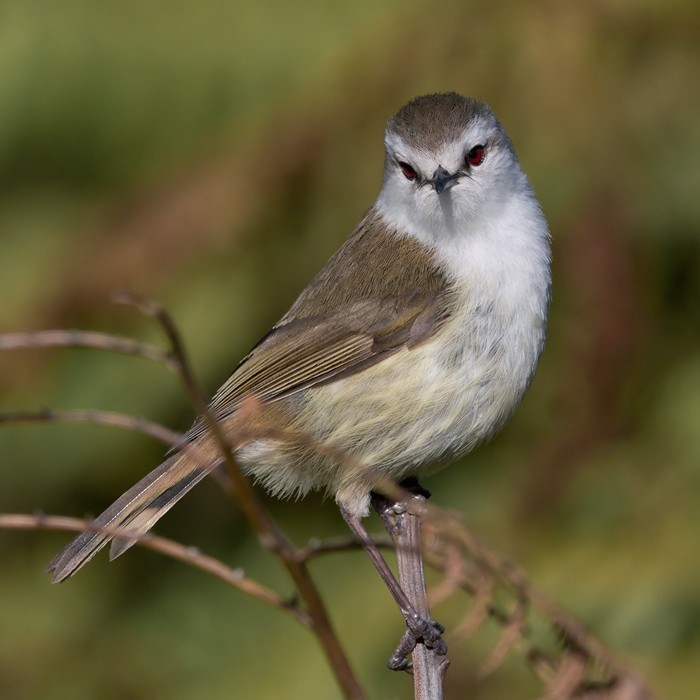Chatham Gerygone
A species of Australasian Warblers, Also known as Chatham Island Warbler Scientific name : Gerygone albofrontata Genus : Australasian Warblers
Chatham Gerygone, A species of Australasian Warblers
Also known as:
Chatham Island Warbler
Botanical name: Gerygone albofrontata
Genus: Australasian Warblers
Content
Description General Info
 Photo By Lars Petersson
Photo By Lars Petersson Description
The Chatham Island warbler has a plain olive-brown head and upperparts, with off-white underparts interrupted by pale yellow flanks and undertail. The male warbler has a distinctive white forehead, eyebrows, throat and underparts. The female warbler lacks these white areas, instead showing dull greyish-white underparts and yellow eyebrows, cheek and throat. Both adults have red eyes. This species of warbler also shows variation in the plumage of the juvenile bird. More akin to the female colouration, the juveniles have olive-grey upperparts and more yellow through their underparts, with brown eyes. Adult Chatham Island warblers of both sexes are about 12 cm (4.7 in) long, but the male slightly outweighs the female adult, with average weights of 10 g (0.35 oz) and 8.5 g (0.30 oz) respectively. The call of the Chatham Island warbler is delicate and intricate. The bird song is said to be similar to that heard from grey warblers that haven't graduated into full song, with initial phrases of four notes recurring throughout the tune. This distinctive call was said to be used by Māori to act as a reminder for when the time came to plant their crops. 
Size
12 cm
Nest Placement
Tree
Feeding Habits
Chatham Gerygone feeds on insects like flies, beetles, moths, caterpillars, and spiders. It forages alone, in pairs, or in groups, usually on the ground among dense forest understorey and shrubland. Preferring to glean from foliage or probe crevices, chatham Gerygone rarely hover-gleans and sometimes associates with the New Zealand Fantail.
Habitat
The habitat of chatham Gerygone predominantly comprises dense native forests, thickets, and shrublands that span from coastal areas to inland plateaux. These birds are also found in regions that have been cleared but are now overgrown with vegetation such as bracken and pohuehue.
Dite type
Insectivorous
General Info
Feeding Habits
Bird food type
Behavior
The Chatham Island warbler's diet consists of small insects such as caterpillars, flies and beetles, and spiders. They feed mainly in the canopy, taking insects from leaves and tree branch crevices, and are also seen to browse the leaf litter. Unlike the grey warbler, the Chatham Island warbler does not hover to collect insects. The Chatham Island warbler are known to occasionally have their nests parasitized by Shining Bronze-cuckoos (Chrysococcyx lucidus). The cuckoo lays an egg in a nest, and hatching first the chick consequently pushes the warbler eggs out of the nest. The cuckoo chick is then fed and raised by the adult warblers. Other threats include rats, cats, and most significantly, habitat reduction. 
Distribution Area
Its natural habitat is temperate forests. Widespread in the southern forest of the main Chatham Island, the warblers are also seen on surrounding islands such as Pitt Island, Little Mangere Island, Star Keys, and Rangatira. Habitat loss and predators are the main causes for the northern boundary seen on the main island. 
Species Status
Thriving in predator-free habitats, the adult warbler population is estimated at around 5000 birds. Although thought to be decreasing, the population numbers have not yet reduced enough to be classified as vulnerable by the IUCN and it is thus categorised as "least concern" on the red list of threatened species. Although this is the case, a recovery plan has been in place in New Zealand due to habitat loss. Main efforts have involved restoring the warblers to the northern sites of Chatham Island, and reforestation to provide future habitats for the population. Control of pests such as cats and weka have also been a focus, although the canopy dwelling birds aren't often affected by these. 

 Photo By Lars Petersson
Photo By Lars Petersson Scientific Classification
Phylum
Chordates Class
Birds Order
Perching birds Family
Australasian warblers Genus
Australasian Warblers Species
Chatham Gerygone